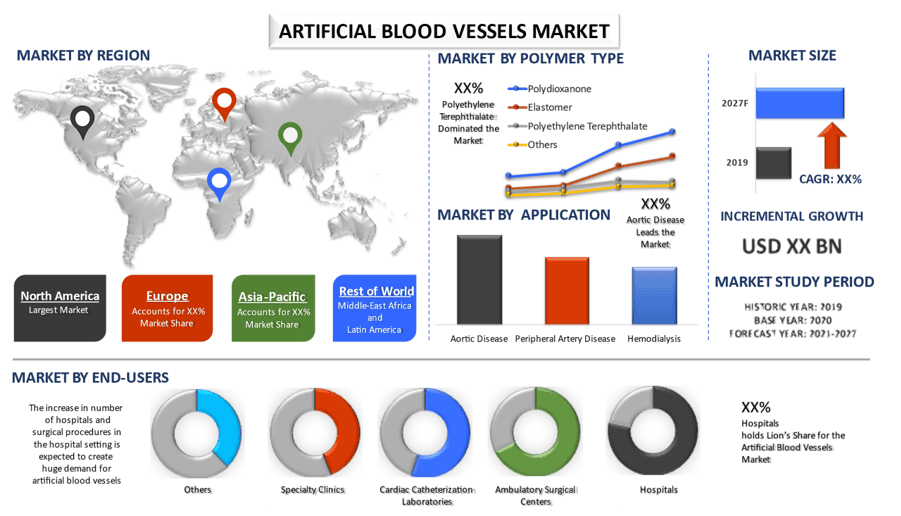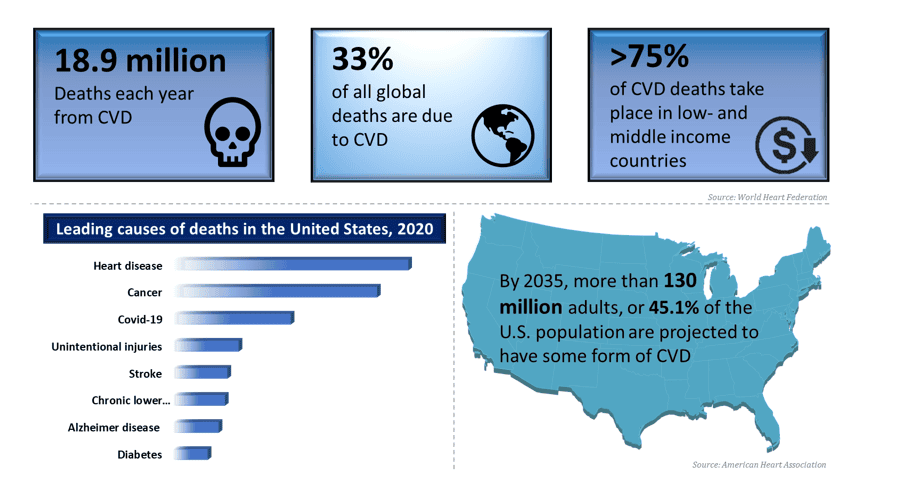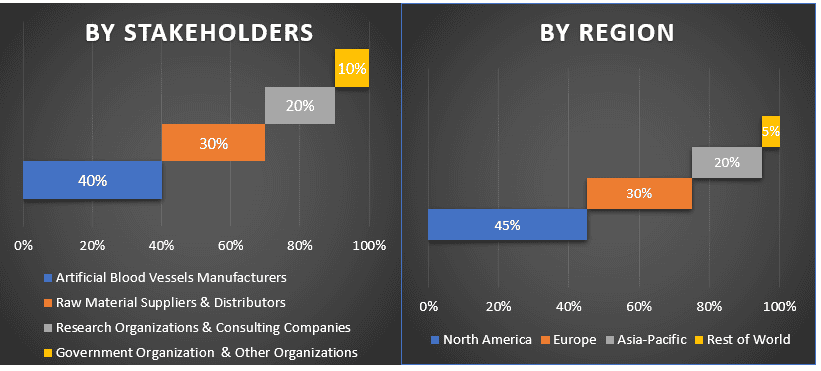
전 세계 인공 혈관 시장은 예측 기간(2021-2027) 동안 약 5%의 높은 연평균 성장률로 성장할 것으로 예상됩니다. 인공 혈관은 치명적인 결과를 초래할 수 있는 손상된 혈관을 대체하는 데 주로 사용되는 다양한 합성 물질로 만들어진 튜브입니다. 폴리디옥사논 및 폴리에틸렌 테레프탈레이트와 같은 생체 고분자는 물과 화학 물질에 대한 높은 저항, 높은 산소 투과성, 높은 전도성과 같은 기계적 특성으로 인해 인공 혈관을 만드는 데 더 일반적으로 사용됩니다.
인공 혈관의 채택 증가는 다양한 심혈관 질환의 유병률 증가와 급속하게 증가하는 노인 인구에 기인할 수 있습니다. 유엔에 따르면 60세 이상 인구는 2017년에 9억 6,200만 명으로 1980년 3억 8,200만 명의 두 배 이상이었습니다. 노인 인구는 2050년까지 다시 두 배로 증가하여 전 세계적으로 약 21억 명에 이를 것으로 예상됩니다. 심혈관 질환의 발생률은 젊은 인구에 비해 노인 인구에서 거의 15% 더 높으며, 이 인구의 증가는 전 세계적으로 심혈관 질환의 수를 증가시킬 것으로 예상됩니다. 따라서 전 세계적으로 인공 혈관 시장을 활성화합니다.
또한, 인공 혈관 시장은 증가하는 기술 발전, 이 분야에서 진행 중인 많은 연구 활동, 증가하는 정부 및 민간-공공 투자, 인공 혈관 구현과 관련된 다양한 이점으로 인해 성장할 것으로 예상됩니다. 일부 이점으로는 유리한 상환 정책, 혈액과 접촉 시 혈액 응고 방지, 치유, 수축 및 천연 혈관과 동일한 부산물을 분비하는 능력과 함께 일부 감염에 대한 높은 저항성이 있습니다. 그러나 엄격한 규제 프레임워크와 이식 및 수술과 관련된 높은 비용을 포함한 시장의 일부 제약은 전 세계적으로 이 시장의 성장을 저해하고 있습니다.
심혈관 질환(CVD): 세계 1위 살인자

- Braun Melsungen, Becton, Dickinson and Company, Cook Medical Incorporated, Medtronic, LeMaitre Vascular Inc., Terumo Medical Corporation, W. L. Gore and Associates, Jotec GmbH, Humacyte Inc., Techshot Inc.는 인공 혈관 시장에서 활동하는 주요 업체 중 일부입니다. 이러한 업체들은 인공 혈관을 고객에게 제공하기 위해 파트너십과 함께 여러 M&A를 수행했습니다.
보고서에 제시된 통찰력
“고분자 유형 중 폴리에틸렌 테레프탈레이트 부문이 주요 점유율을 차지합니다.”
고분자 유형에 따라 인공 혈관 시장은 폴리디옥사논, 엘라스토머, 폴리에틸렌 테레프탈레이트 등으로 세분화됩니다. 폴리에틸렌 테레프탈레이트 부문은 2020년에 상당한 시장 점유율을 차지했으며 다양한 임상 응용 분야에서 혈관 이식편에 대한 표준 생체 재료로 현재 사용되고 있는 생체 안정성 고분자이기 때문에 예측 기간 동안 빠르게 성장할 것으로 예상됩니다. 이 생체 재료는 대구경 혈관 이식편(>6mm)으로 성능이 우수하기 때문에 1970년대부터 인간에게 널리 사용되었습니다.
“응용 분야 중 대동맥 질환 부문이 주요 점유율을 차지합니다.”
응용 분야에 따라 인공 혈관 시장은 대동맥 질환, 말초 동맥 질환 및 혈액 투석으로 나뉩니다. 대동맥 질환 부문은 2020년에 인공 혈관 시장의 주요 점유율을 차지했으며 향후 몇 년 동안 상당한 연평균 성장률로 성장할 것으로 예상됩니다. 이 부문의 성장은 대동맥에 손상을 일으키고 환자를 생명을 위협하는 위험에 빠뜨릴 수 있는 다양한 의학적 상태 및 질병의 유병률 증가에 기인합니다. 이러한 의학적 상태에는 죽상 동맥 경화증, 유전적 상태, 결합 조직 장애, 고혈압 등이 있습니다. 예를 들어, 세계 보건 기구에 따르면 전 세계적으로 30~79세 성인 약 12억 8천만 명이 고혈압을 앓고 있습니다. 그러나 만성 신장 질환을 앓고 있는 사람들의 수가 증가함에 따라 혈액 투석 부문도 예측 기간 동안 상당히 성장할 것으로 예상됩니다.
“최종 사용자 중 병원 부문이 주요 점유율을 차지합니다.”
최종 사용자를 기준으로 시장은 병원, 심장 도관 삽입 연구소, 외래 수술 센터, 전문 클리닉 등으로 나뉩니다. 2020년에는 병원 부문이 상당한 시장 점유율을 차지했으며 병원 건설 증가와 병원 환경에서 심장 수술 건수 급증으로 인해 예측 기간 동안 상당한 연평균 성장률로 성장할 것으로 예상됩니다. 그러나 외래 수술 센터도 예측 기간 동안 가장 빠른 성장을 보일 가능성이 높습니다.
“북미는 인공 혈관 시장의 가장 큰 시장 중 하나를 나타냅니다.”
인공 혈관 시장의 시장 역학을 더 잘 이해하기 위해 북미(미국, 캐나다, 북미 나머지 지역), 유럽(독일, 프랑스, 스페인, 영국, 이탈리아, 유럽 나머지 지역), 아시아 태평양(중국, 인도, 호주, 일본, APAC 나머지 지역)을 포함한 전 세계 여러 지역에 대한 자세한 분석이 수행되었습니다. 북미는 인공 혈관 시장 산업의 주요 시장을 구성하며 강력한 의료 인프라와 지역에서 인공 혈관 채택 증가로 인해 2020년에 10억 달러의 수익을 창출했습니다.
이 보고서를 구매해야 하는 이유:
- 이 연구에는 인증된 주요 업계 전문가가 검증한 시장 규모 조정 및 예측 분석이 포함되어 있습니다.
- 이 보고서는 전체 산업 성과에 대한 간략한 검토를 한눈에 제공합니다.
- 이 보고서는 주요 비즈니스 재무, 제품 포트폴리오, 확장 전략 및 최근 개발에 중점을 두고 주요 업계 동료에 대한 심층 분석을 다룹니다.
- 업계에 만연한 동인, 제약, 주요 트렌드 및 기회에 대한 자세한 조사
- 이 연구는 다양한 부문에 걸쳐 시장을 포괄적으로 다룹니다.
- 산업에 대한 심층적인 지역 수준 분석
맞춤화 옵션:
글로벌 인공 혈관 시장은 요구 사항 또는 기타 시장 부문에 따라 더욱 맞춤화될 수 있습니다. 이 외에도 UMI는 귀하가 고유한 비즈니스 요구 사항을 가지고 있을 수 있음을 이해하므로 귀하의 요구 사항에 완벽하게 맞는 보고서를 얻기 위해 언제든지 저희에게 연락하십시오.
목차
글로벌 인공 혈관 시장의 과거 시장 분석, 현재 시장 추정, 미래 시장 예측은 전 세계 주요 지역에서 인공 혈관 채택을 분석하고 생성하기 위해 수행된 세 가지 주요 단계였습니다. 과거 시장 수치를 수집하고 현재 시장 규모를 추정하기 위해 광범위한 2차 연구가 수행되었습니다. 둘째, 이러한 통찰력을 검증하기 위해 수많은 결과 및 가정이 고려되었습니다. 또한 글로벌 인공 혈관 시장의 가치 사슬 전반에 걸쳐 업계 전문가들과 광범위한 1차 인터뷰도 수행되었습니다. 1차 인터뷰를 통해 시장 수치를 가정하고 검증한 후, 전체 시장 규모를 예측하기 위해 하향식/상향식 접근 방식을 사용했습니다. 이후 시장 세분화 및 데이터 삼각 측량 방법을 채택하여 산업과 관련된 세그먼트 및 하위 세그먼트의 시장 규모를 추정하고 분석했습니다. 자세한 방법론은 아래에 설명되어 있습니다.
과거 시장 규모 분석
1단계: 2차 자료에 대한 심층 연구:
연례 보고서 및 재무제표, 실적 발표, 보도 자료 등 회사 내부 자료와 저널, 뉴스 및 기사, 정부 간행물, 경쟁사 간행물, 부문 보고서, 타사 데이터베이스 및 기타 신뢰할 수 있는 간행물 등 외부 자료를 통해 인공 혈관의 과거 시장 규모를 확보하기 위해 세부적인 2차 연구가 수행되었습니다.
2단계: 시장 세분화:
인공 혈관 시장의 과거 시장 규모를 확보한 후, 주요 지역에 대한 다양한 세그먼트 및 하위 세그먼트에 대한 과거 시장 통찰력과 점유율을 수집하기 위해 자세한 2차 분석을 수행했습니다. 보고서에 포함된 주요 세그먼트는 폴리머 유형, 응용 분야 및 최종 사용자를 포함합니다. 또한 전 세계적으로 인공 혈관의 전체 채택을 평가하기 위해 국가별 분석이 수행되었습니다.
3단계: 요인 분석:
다양한 세그먼트 및 하위 세그먼트의 과거 시장 규모를 확보한 후, 인공 혈관의 현재 시장 규모를 추정하기 위해 자세한 요인 분석을 수행했습니다. 또한 기술의 발전과 대동맥 질환의 유병률 증가와 같은 종속 및 독립 변수를 사용하여 요인 분석을 수행했습니다. 전 세계 인공 혈관 부문에서 최고의 파트너십, 합병 및 인수, 사업 확장 및 제품 출시를 고려하여 수요 및 공급 측면 시나리오에 대한 철저한 분석이 수행되었습니다.
현재 시장 규모 추정 및 예측
현재 시장 규모 산정: 위의 3단계의 실행 가능한 통찰력을 기반으로 인공 혈관 시장의 현재 시장 규모, 주요 업체 및 세그먼트의 시장 점유율을 파악했습니다. 필요한 모든 백분율 점유율 분할 및 시장 세분화는 위에서 언급한 2차 접근 방식을 사용하여 결정되었으며 1차 인터뷰를 통해 확인되었습니다.
추정 및 예측: 시장 추정 및 예측을 위해 이해 관계자가 이용할 수 있는 동인 및 추세, 제약 및 기회를 포함한 다양한 요인에 가중치가 할당되었습니다. 이러한 요인을 분석한 후, 관련 예측 기술(즉, 하향식/상향식 접근 방식)을 적용하여 전 세계 주요 시장에서 다양한 세그먼트 및 하위 세그먼트에 대한 2027년경의 시장 예측에 도달했습니다. 시장 규모를 추정하기 위해 채택된 연구 방법론은 다음을 포함합니다.
- 가치(미화) 측면에서 업계의 시장 규모와 국내 주요 시장에서 인공 혈관의 채택률
- 시장 세그먼트 및 하위 세그먼트의 모든 백분율 점유율, 분할 및 세분화
- 제공되는 제품 측면에서 인공 혈관 시장의 주요 업체. 또한 빠르게 성장하는 시장에서 경쟁하기 위해 이러한 업체가 채택한 성장 전략
시장 규모 및 점유율 검증
1차 연구: 주요 지역의 최고 경영진(CXO/VP, 영업 책임자, 마케팅 책임자, 운영 책임자, 지역 책임자, 국가 책임자 등)을 포함한 핵심 오피니언 리더(KOL)와 심층 인터뷰를 진행했습니다. 그런 다음 1차 연구 결과를 요약하고 명시된 가설을 입증하기 위해 통계 분석을 수행했습니다. 1차 연구의 입력은 2차 결과와 통합되어 정보를 실행 가능한 통찰력으로 전환했습니다.
다양한 지역의 1차 참가자 분할

시장 엔지니어링
데이터 삼각 측량 기술은 전체 시장 추정을 완료하고 인공 혈관 시장의 각 세그먼트 및 하위 세그먼트의 정확한 통계 수치에 도달하기 위해 사용되었습니다. 인공 혈관 시장의 폴리머 유형, 응용 분야 및 최종 사용자 영역에서 다양한 매개변수와 추세를 연구한 후 데이터를 여러 세그먼트 및 하위 세그먼트로 분할했습니다.
인공 혈관 시장 연구의 주요 목표
인공 혈관의 현재 및 미래 시장 추세는 연구에서 정확히 지적되었습니다. 투자자는 연구에서 수행된 질적 및 양적 분석에서 투자를 위한 재량에 대한 전략적 통찰력을 얻을 수 있습니다. 현재 및 미래 시장 추세는 지역 수준에서 시장의 전반적인 매력을 결정하여 산업 참가자가 미개척 시장을 활용하여 선점자 이점을 얻을 수 있는 플랫폼을 제공했습니다. 연구의 다른 양적 목표는 다음과 같습니다.
- 가치(미화) 측면에서 인공 혈관의 현재 및 예측 시장 규모를 분석합니다. 또한 다양한 세그먼트 및 하위 세그먼트의 현재 및 예측 시장 규모를 분석합니다.
- 연구의 세그먼트에는 폴리머 유형, 응용 분야 및 최종 사용자 영역이 포함됩니다.
- 인공 혈관 산업에 대한 규제 프레임워크 정의 및 분석
- 다양한 중개자의 존재와 관련된 가치 사슬을 분석하고 업계의 고객 및 경쟁자 행동을 분석합니다.
- 주요 지역에 대한 인공 혈관 시장의 현재 및 예측 시장 규모를 분석합니다.
- 보고서에서 연구된 주요 지역에는 북미, 유럽, 아시아 태평양 및 기타 지역이 포함됩니다.
- 인공 혈관 시장의 회사 프로필과 빠르게 성장하는 시장에서 지속하기 위해 시장 플레이어가 채택한 성장 전략
산업에 대한 심층적인 지역 수준 분석
관련 보고서
이 상품을 구매한 고객님들도 함께 구매하신 상품










